Skopje, capital city of Macedonia, is a dream world for lovers of cosmic concrete communist-era architecture. There is a reason that no other city on Earth has as many examples of brutalist architecture. There’s no tactful way to say this – the abundance of magnificent structures, is all due to a catastrophic earthquake that killed over 2000 people, and destroyed more than half of the buildings in this ancient city. In 1963, Skopje was flattened. In 1965, Japanese architect Kenzo Tange was selected as the winner of an international competition to redesign, and rebuild the city centre.
Napier – the small New Zealand city where my travelling partner Phillipa was born, suffered a similar fate. The great quake of Napier in 1931 occurred right at the peak of the Art Deco movement. Napier was destroyed, and then rebuilt, all in the early 1930’s. As a result, the city can rightfully claim the title of “art deco capital of the world”. Back in Skopje, 1963, the architectural trend wasn’t art-deco, it was modernist, with a particular focus on concrete brutalism. Unlike Napier, Skopje has yet to capitalise on its architectural heritage. I would suggest a new tourist slogan – “Skopje – Brutalist Capital of the World”. Perhaps it’s not as catchy.
Examples of brutalist architecture – a style typified by geometric themes and raw concrete – occur all over the formerly communist area of Yugoslavia. In Zagreb, in Belgrade, and in nearly every small town, exist examples from this era. However, it is the legacy of Kenzo Tange, that makes Skopje so special in this regard. Locals are indifferent about memories of the Yugoslavia communist-era in general, however most people I have spoken to when visiting these buildings are familiar with Kenzo Tange. And whether they are particularly a fan of this style of architecture or not is beside the point – it’s clear that the positive impact Kenzo Tange had on the community of Skopje, in the wake of a devastating natural event, will not soon be forgotten.
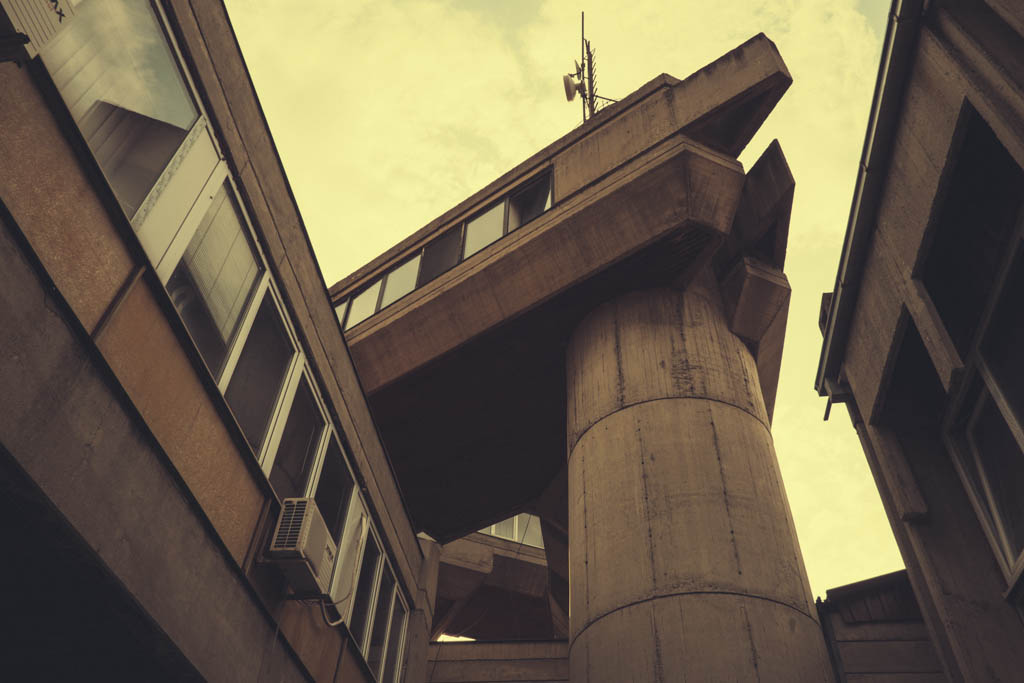
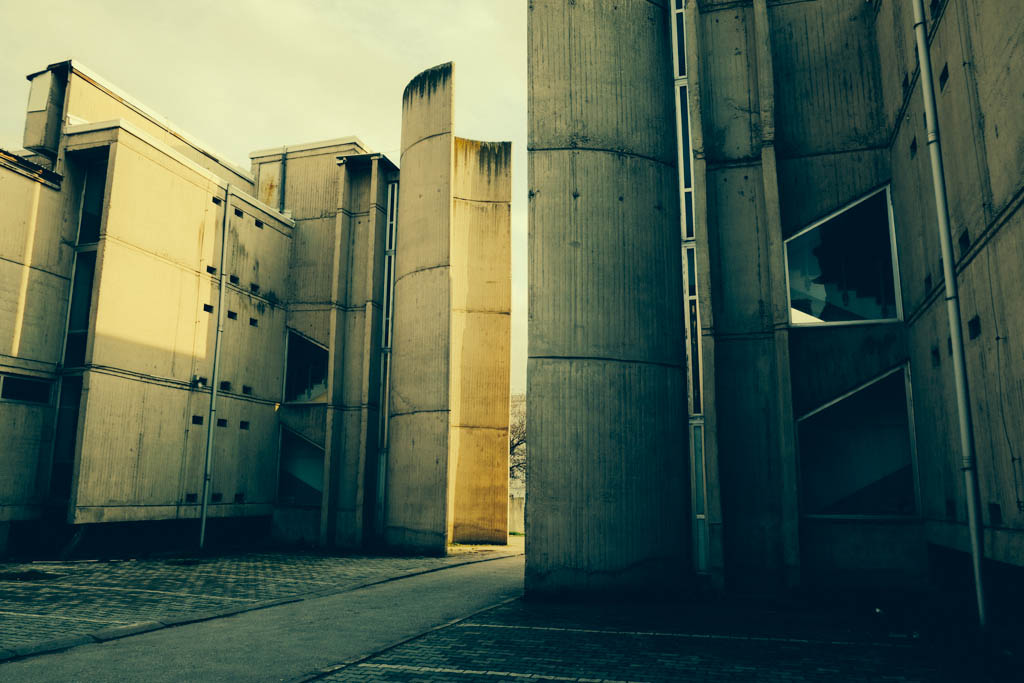
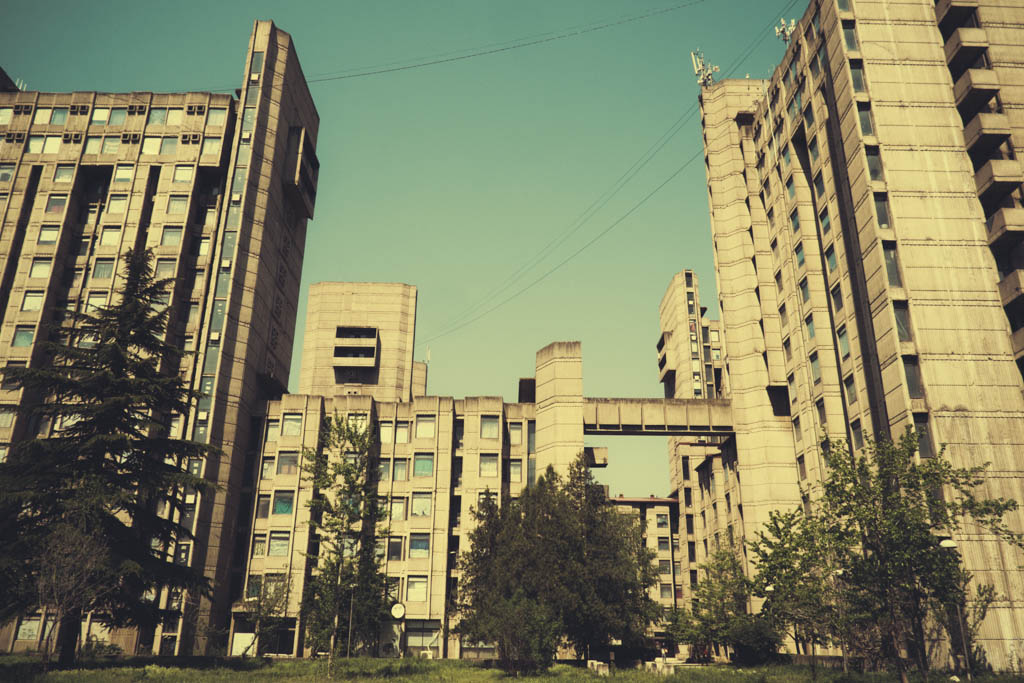
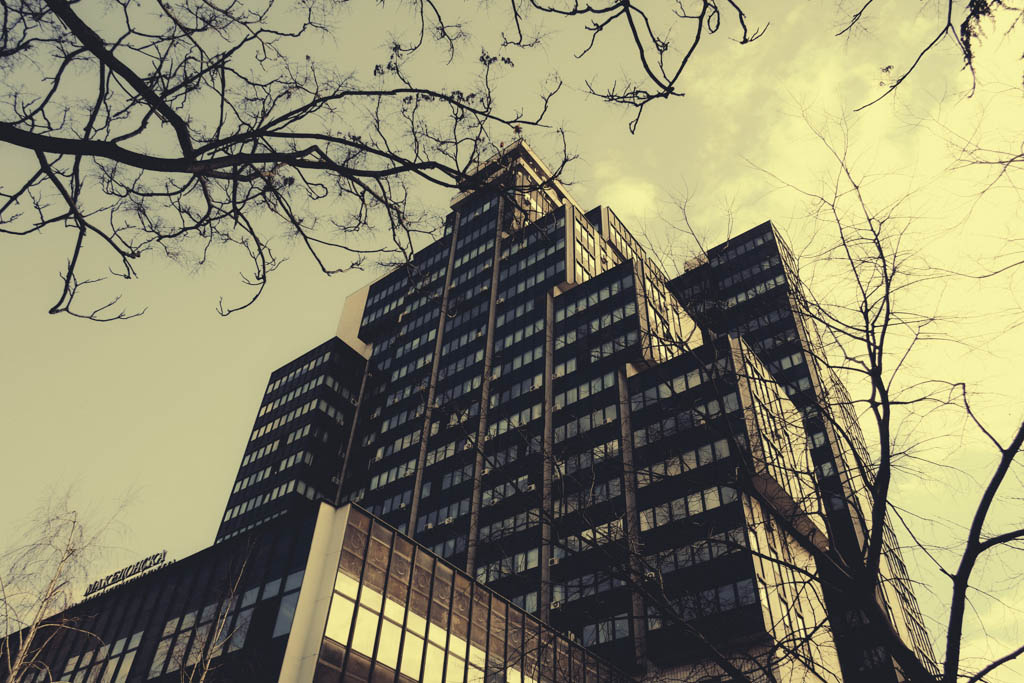
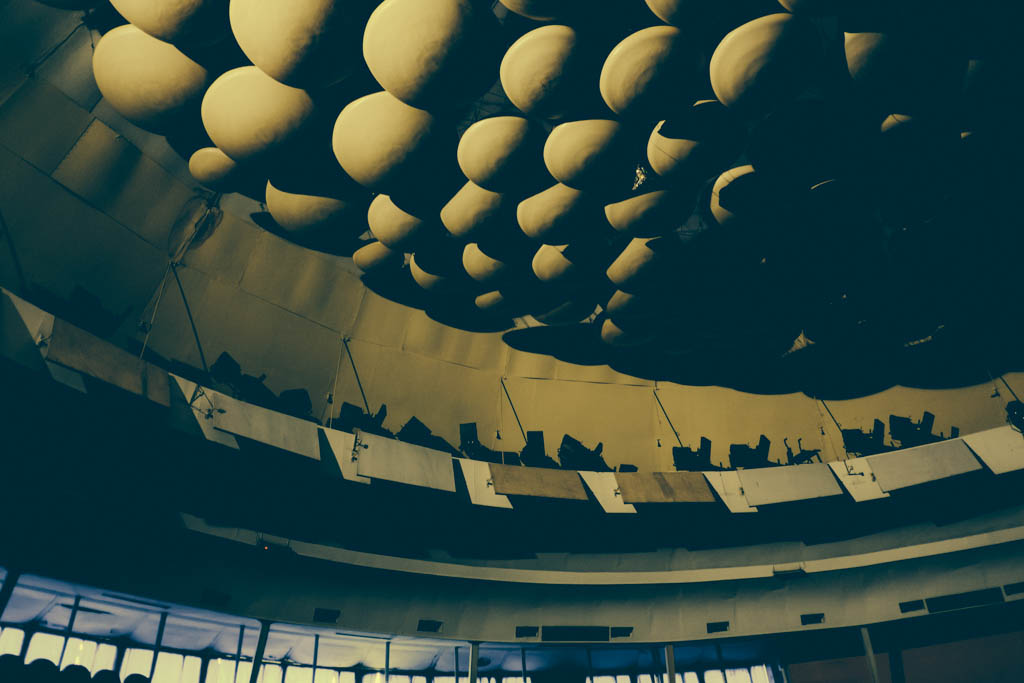
And this is the part of the article where we deal with some problems of terminology. Macedonia, officially “The Republic of Macedonia” or “The Former Yugoslav Republic of Macedonia” depending on which international body you are speaking to, declared independence from communist Yugoslavia in 1991. The naming issue is telling, for a country whose government is seemingly hell bent on rebuilding its history (some people would say rewriting history), even the name of the country may not be final.
Due to a dispute with Greece, and in particular the Greek region just across the shared border also known as Macedonia, The Republic of Macedonia was admitted to the United Nations only with the provisional name of FYROM. But this soviet-esque abbreviation is already out of favor with many UN members. Apologies to Greece, but it appears the name FYROM will be going the same way as Rhodesia, The Dutch East Indies, and Upper Volta. To most people around the world, Macedonia, is Macedonia.
Brutalist, Modernist, But Not Communist Architecture?
Macedonian naming issues aside, there is another problem when referring to this style of architecture. Of course, it isn’t “communist architecture”. Kenzo Tange was certainly not communist, for a start. However, the fact remains that all of the architecture featured in this article, was indeed constructed during a period in which Macedonia was a part of “communist” Yugoslavia. I should also add that the Yugoslavian leader Tito ruled his nation seemingly benevolently, and was a much loved politician. There was no Iron Curtain in Yugoslavia, despite that this is the very region where the term originated. Much like China today, or the United States for that matter, Yugoslavians were encouraged to be capitalist consumers. They didn’t suffer restrictions on leaving the country, as was occurring in much of the rest of Eastern Europe during this period. So the issue of “communism” is complex in the case of Yugoslavia, and beyond the scope of this article.
Kenzo Tange and his Japanese team aside, the other architects of these structures may or may not have identified as communists, or socialists. The term is used these days, simply to denote a period in time. For westerners, the term communist architecture has come to denote the stark, efficient, cosmic, brutal, distinctive and unique style of Balkans area architecture that was often decidedly different from what was being built elsewhere. Personally, I think it’s a beautiful style. A venture into the interiors of any of these buildings will show that both form and function were frequently mastered.

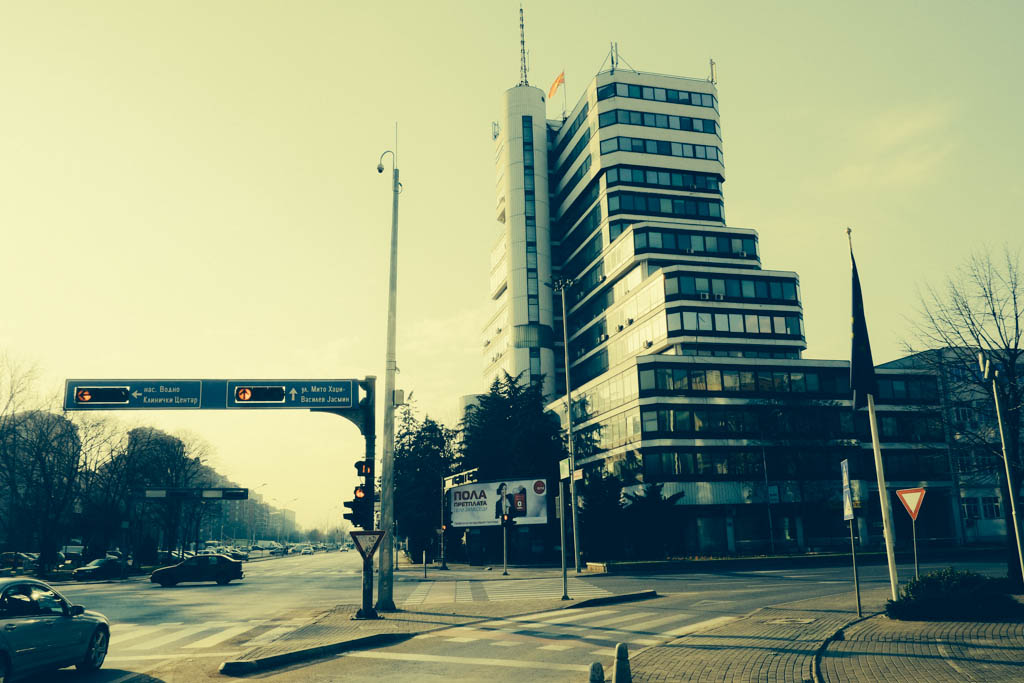
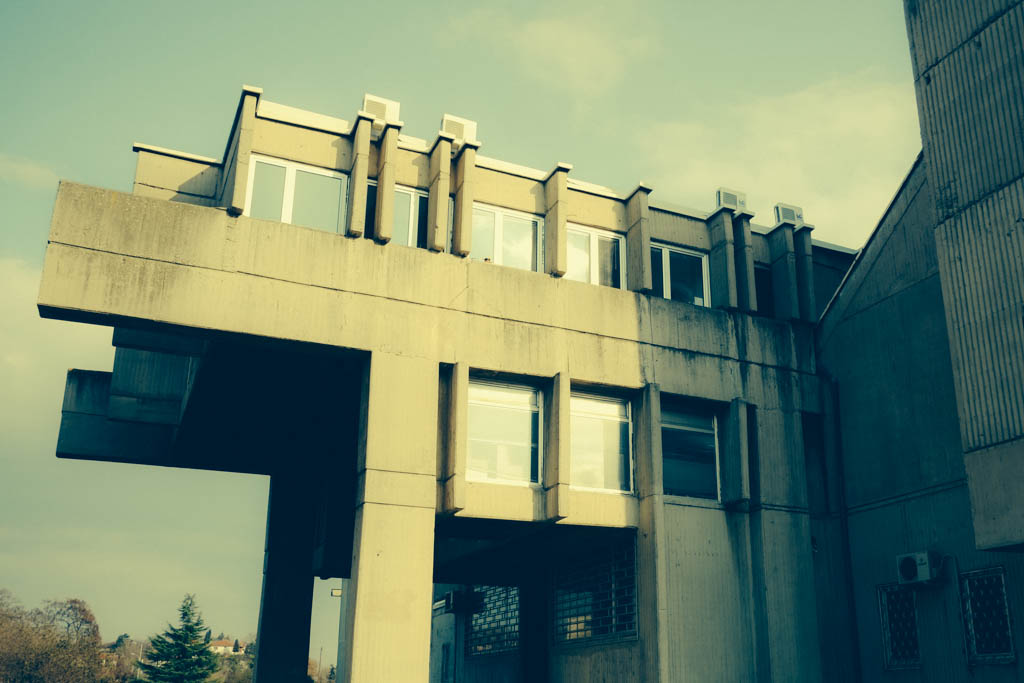

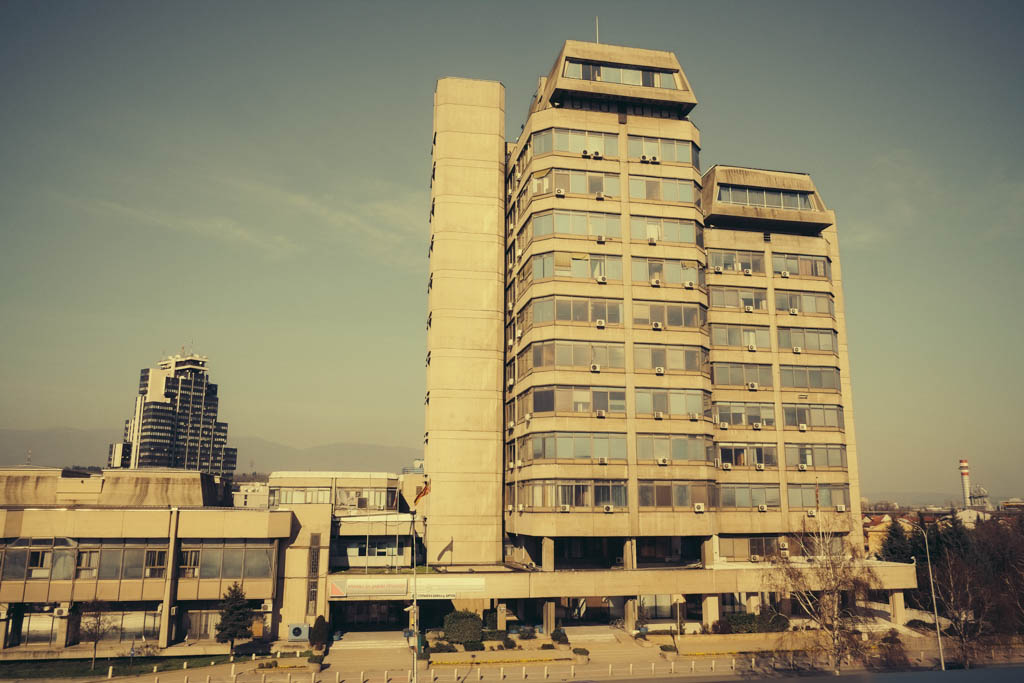
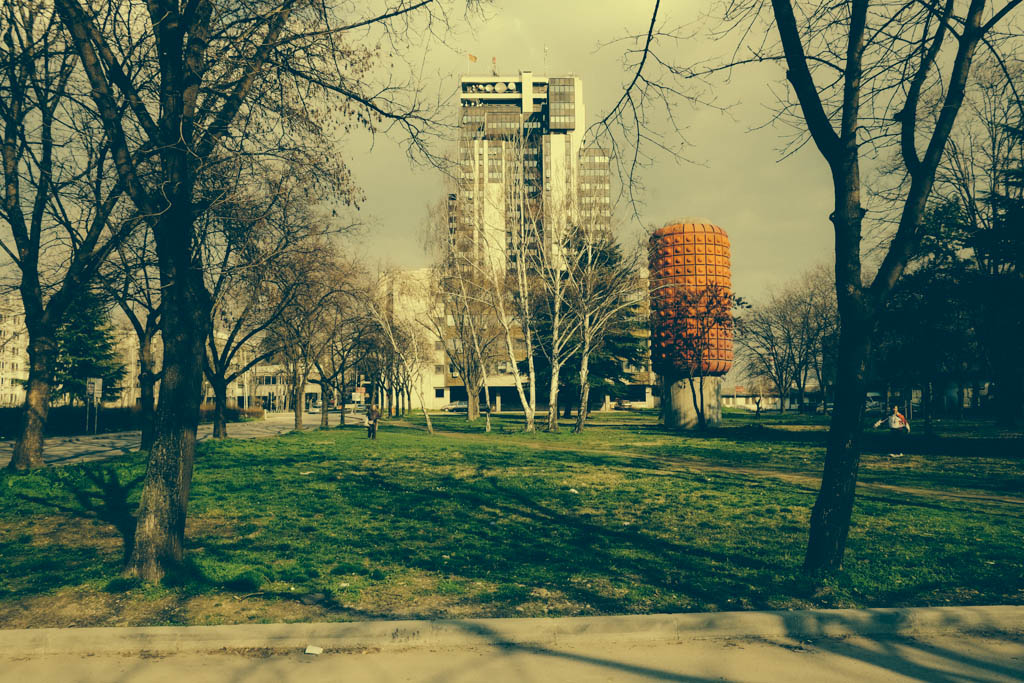
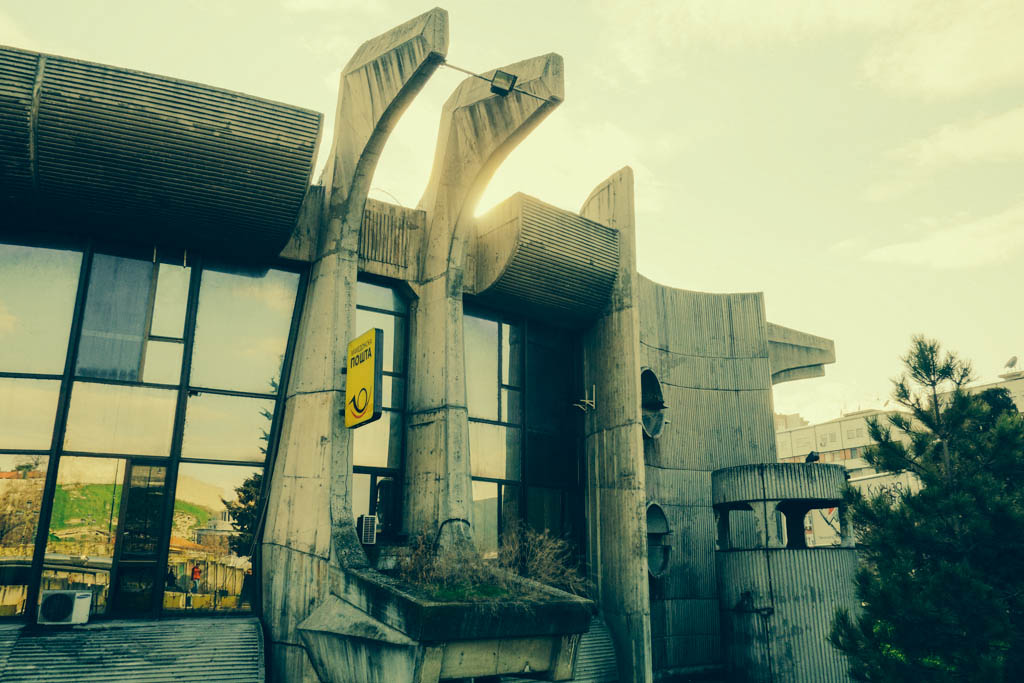
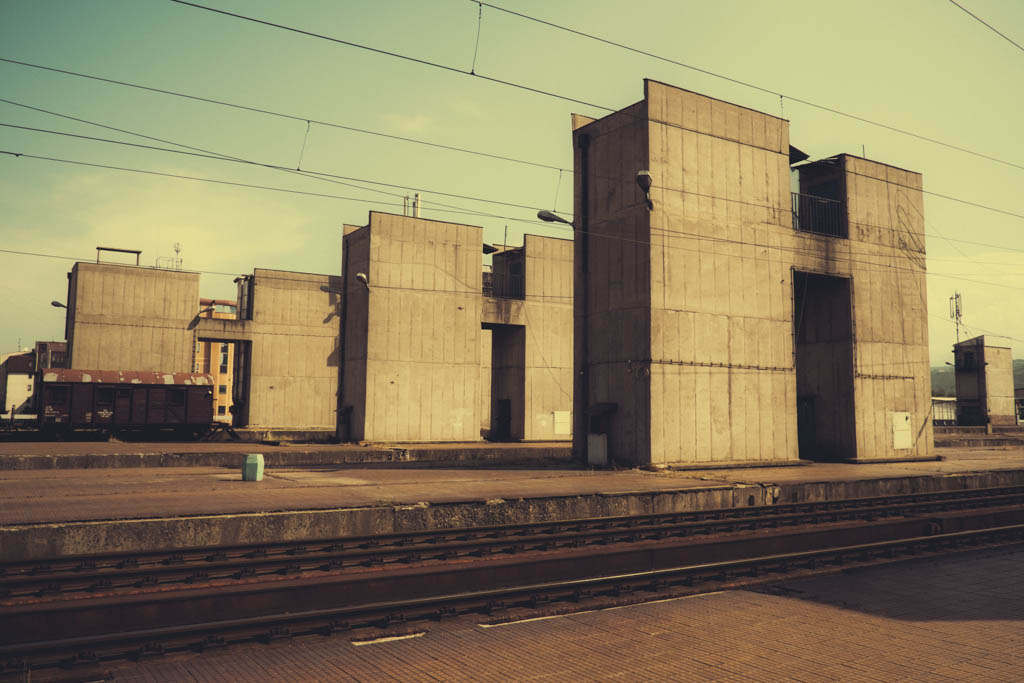
With a population of around half a million, Skopje would be considered a small city. In its compact layout, it holds more brutal architecture than any other comparable city on Earth. It doesn’t have the suburban fields of concrete apartment buildings found in the “Blokovi” of Novi Beograd in Serbia, or to a lesser degree Novi Zagreb in Croatia, but the depth of architectural brutalism in Skopje is perhaps more astounding. Almost all of the buildings featured are all easily accessible, located either right in the center of the city, or within a few minutes of it.
Unfortunately, the Macedonian authorities do not share the same love of this contemporary architectural heritage. Many of the brutal and modern buildings of the communist era remain in government hands, and yet many are being allowed to decay. It won’t be long before some are past the point of no return. In a country that is suffering horrendous unemployment, you could be excused for thinking that the not-exactly-wealthy Macedonian government simply doesn’t have the time, resources, or money to maintain these buildings. However, this is not the case.
Skopje is currently in the thick of a construction boom. Museums, upgrades to Parliament House, decorative bridges, and more are being constructed everywhere. There are hundreds of bronze statues being erected all over the city center. I have never seen so many statues in one city. This initiative is all about Macedonian identity. The issues are deep, and the history is complex, but essentially the government has decided to prioritise, create, and invest in the ancient/historical Macedonian identity – at the expense of maintaining the absolutely unique and contemporary stock of buildings that were created in the second half of the 20th century.
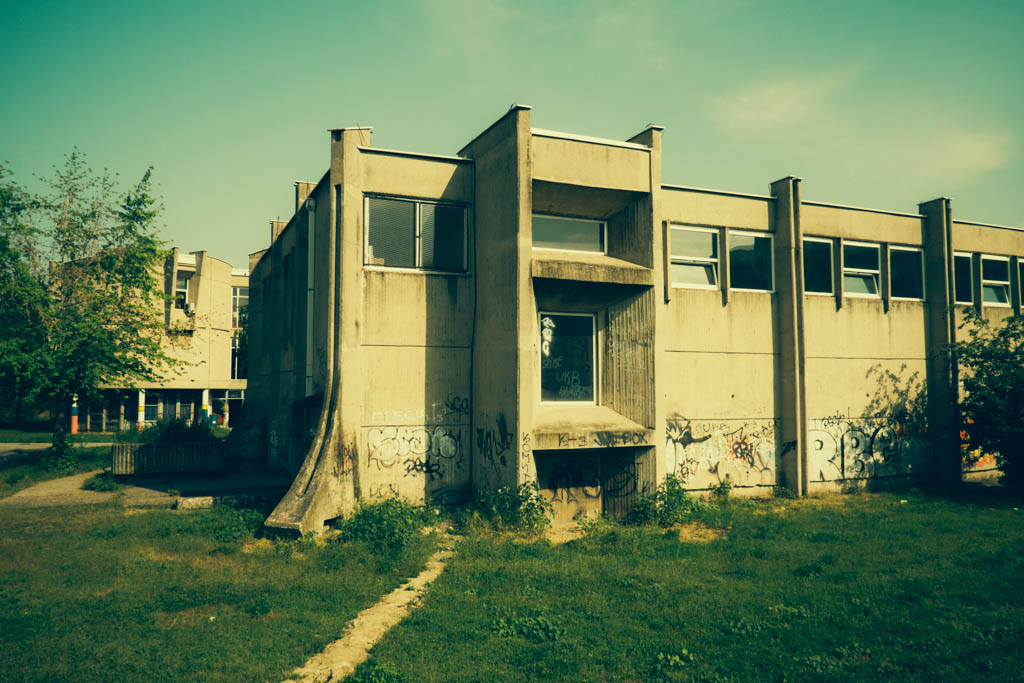
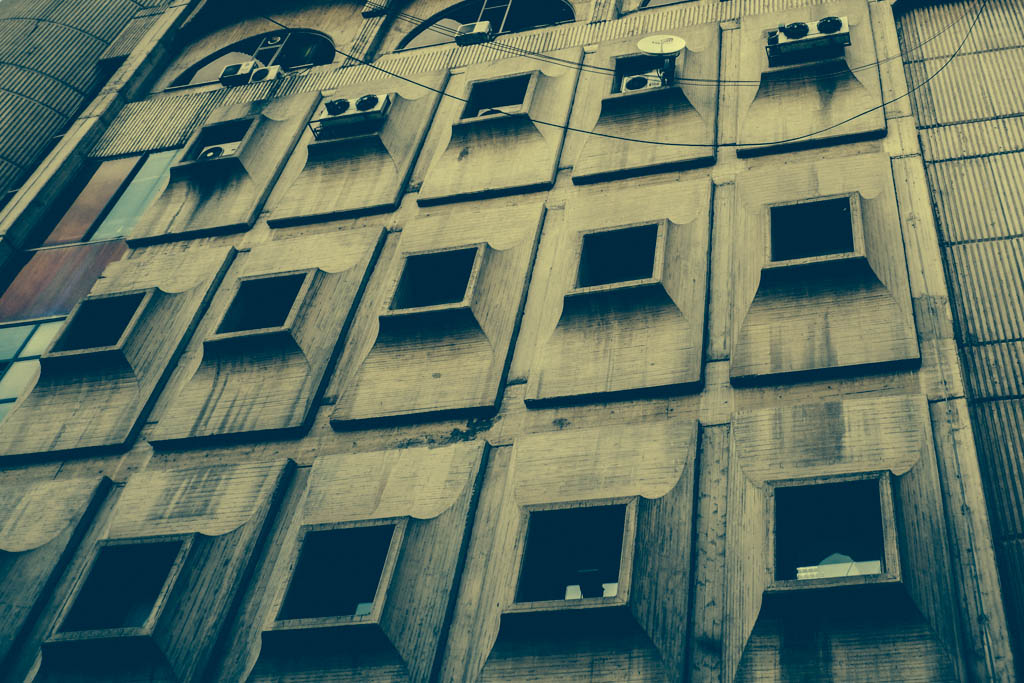
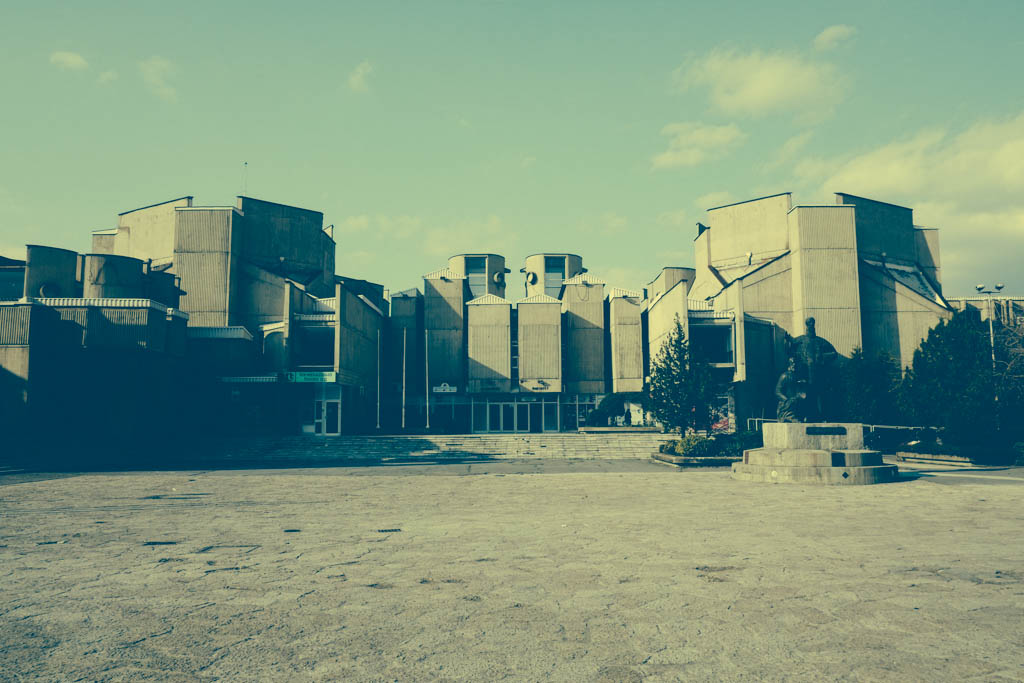
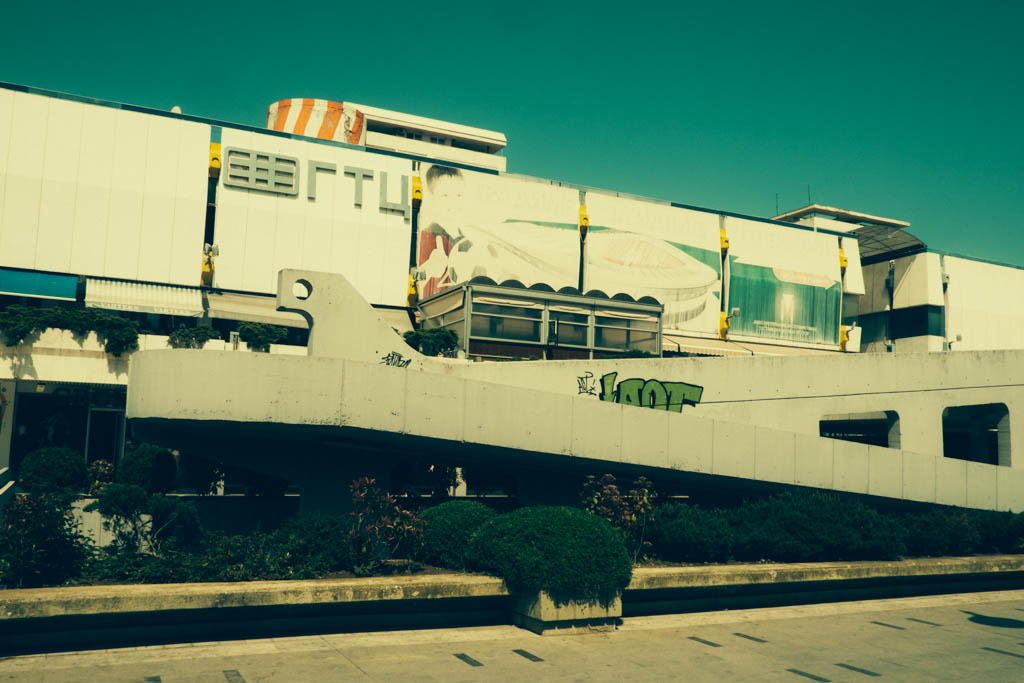
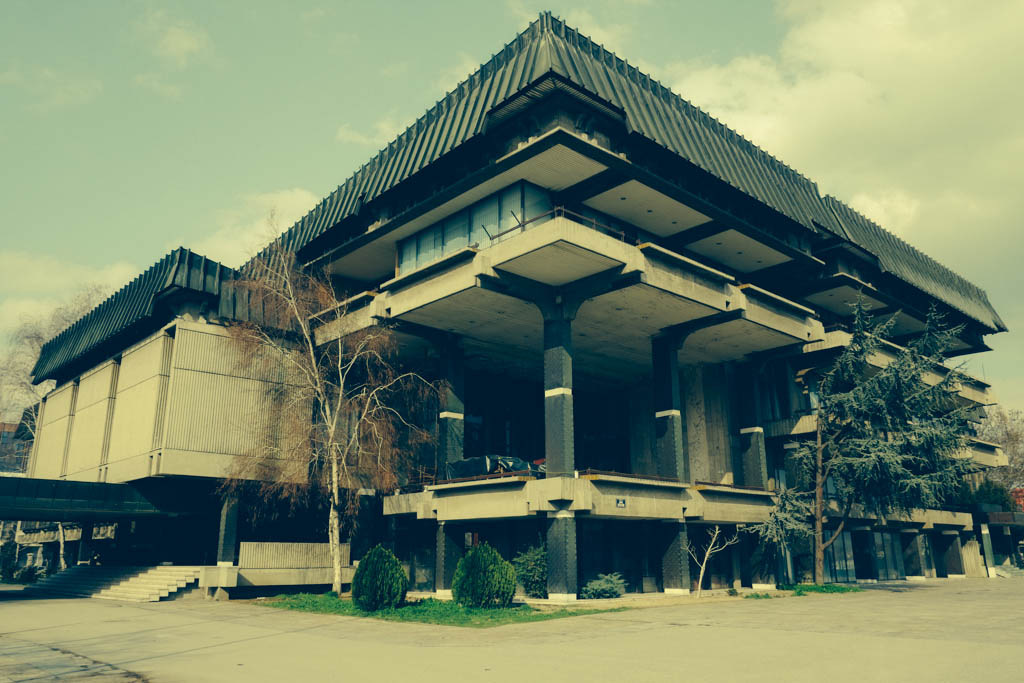
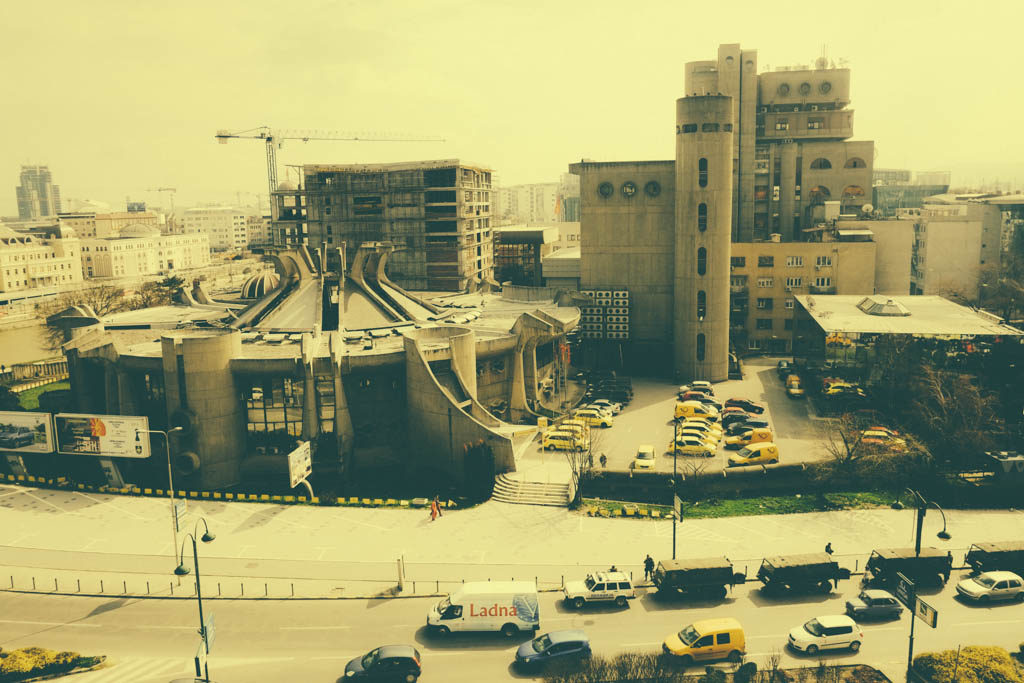
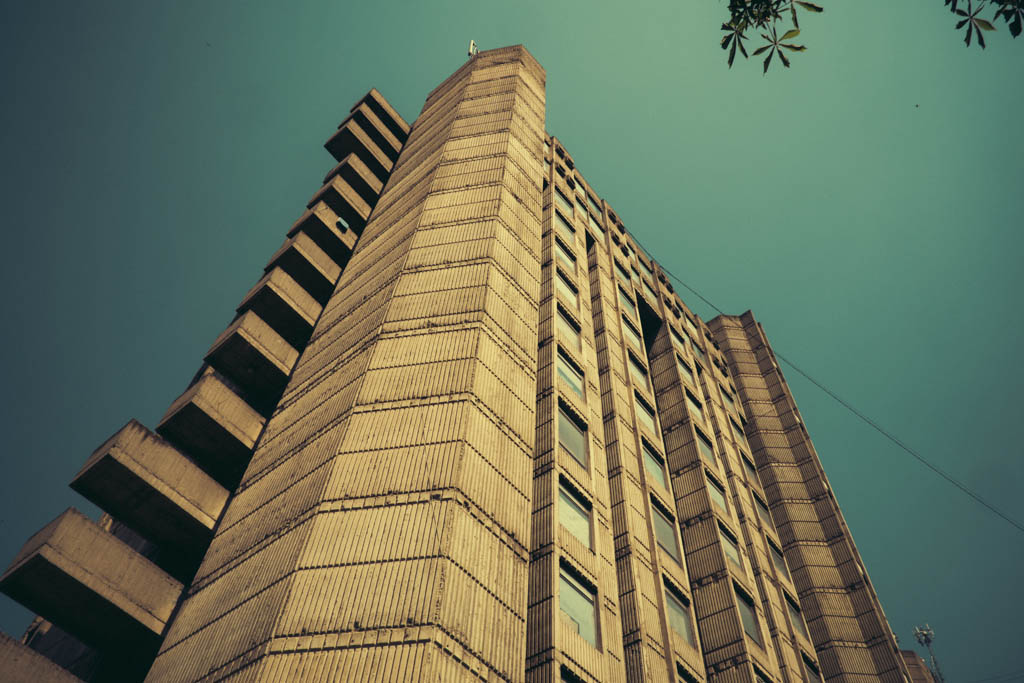
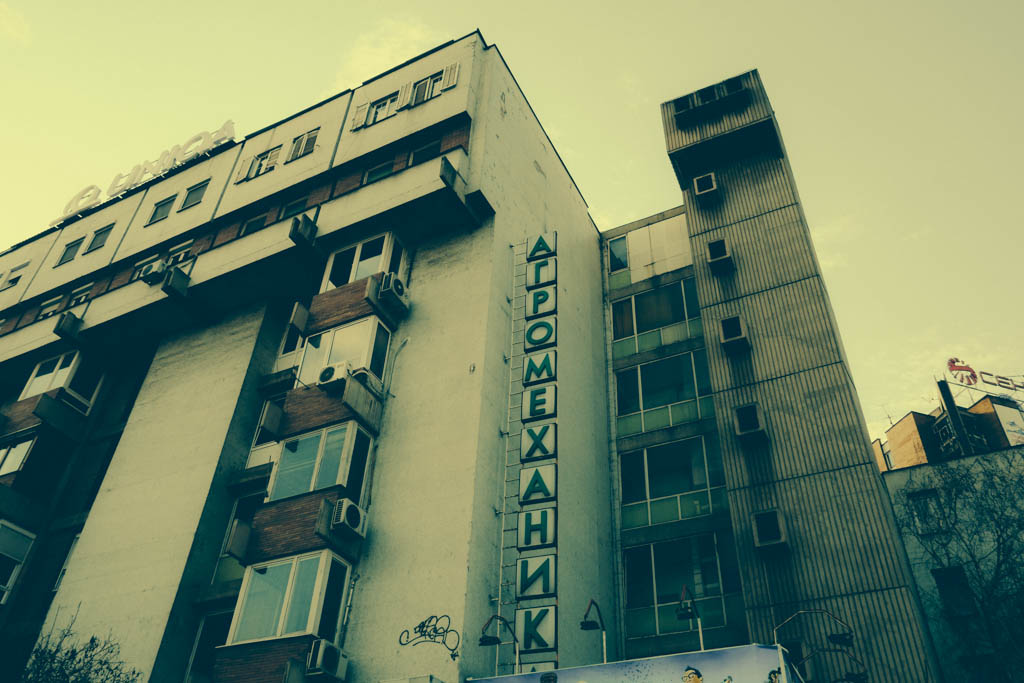
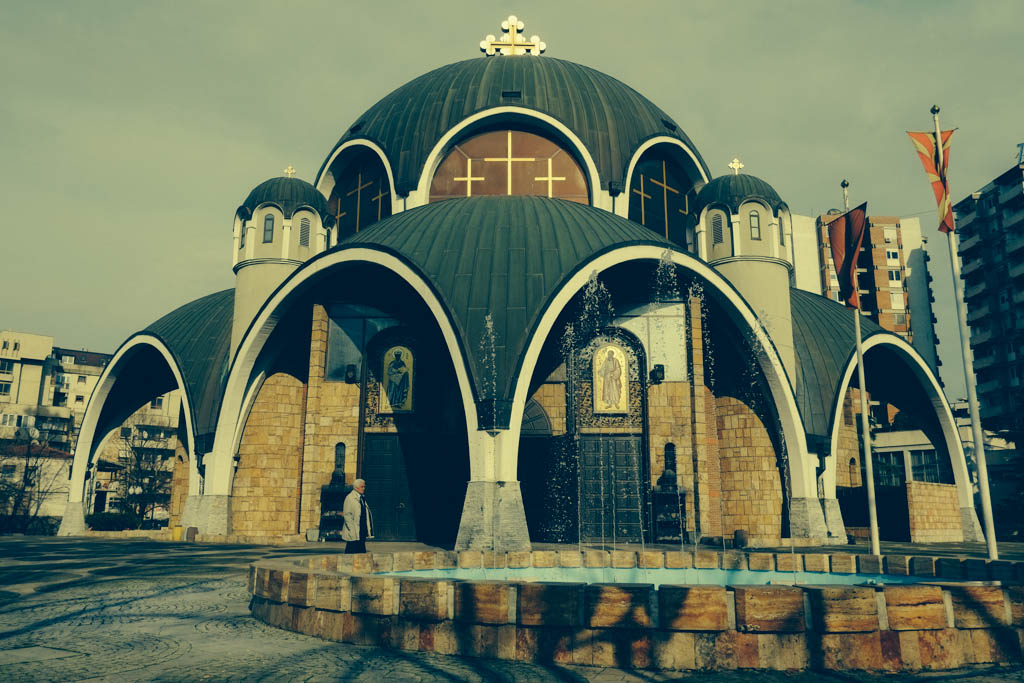


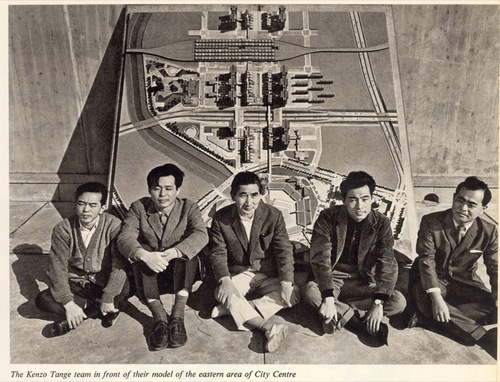
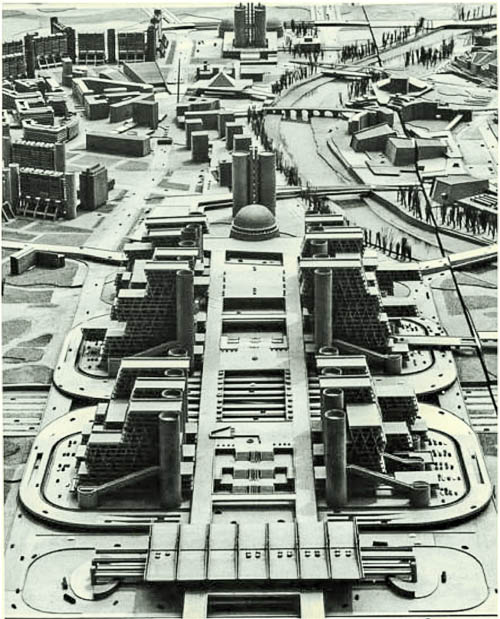
click to see an interactive map showing the location of this article
I’m not entirely sure what the point of the new Las Vegas/Disneyland-esque government sponsored construction drive is. For such a small city, it’s an extreme, and costly, effort. Skopje’s locals are divided, but I think it’s safe to say most are against the government spending such large sums of money on what is a fairly kitsch effort at creating a national identity. It’s hard not to draw comparisons back to the propagandish era of communist Yugoslavia. The architecture itself is perhaps best described as tacky, albeit grand. However, tastes vary, and they change – and Skopje’s new architecture may yet prove to be a hit with tourists. Only time will tell.
Yugoslavia in the 1960’s must have been a truly fascinating place. Skopje, in 2013, is definitely a fascinating place. The city center holds concrete masterpieces sitting alongside every possible era of architecture from the last two millennium. An ancient Castle fortress looks down from one side, and the worlds biggest cross sits atop an inner city mountain on the other. On one side of the Vardar river that cuts through the city center, is a ancient neighbourhood that could be straight out of Istanbul. On the other, the city square with an enormous “Man On a Horse” statue (just don’t say it’s Alexander the Great, believe me) is a pleasurable and walk-able area normally bustling with activity. Connecting the two areas, is the Stone Bridge, built about 700 years ago – on top of much older Roman foundations. The layers and the contrast is unique for any city of this size.
I love this city. If you visit Skopje, I’m pretty sure you’ll love it to. It’s changing very fast at the moment. You could visit Skopje now, or in a few years when the construction dust has settled. Either way, it has something for everyone, is inexpensive, the locals are friendly, and you will just not believe your eyes when you get here.
And despite what this this collection of photos is telling you, Skopje is far more than just a communist era brutal concrete wonderland.
Nate
UPDATE 8th May 2013. Below is a photo of a modernist style government building in the center of Skopje, designed by architect Peter Mulichkoski, from 1970. Personally, I think it’s a great building, but it was left it from the original article above as I was concentrating more on the concrete brutalist style of architecture. However, this is a great representation of just what is happening in Skopje. The facade on this building will be changed, at a cost of 10 million Euro dollars, from classic 1970 – to a faux, or fake, neoclassical style facade. Personally, I see this as tragic. In my own city of Perth, Australia – a building from the 1960’s which holds the local government council was once considered the “ugliest” in the city, and plans were made to demolish it. Now, the same building is one of the favourites in the whole city. You only get one chance to retain your architectural heritage.
UPDATE 28th May 2013. There has been an article written in the news portal kurik.mk . The conclusions drawn appear to be inaccurate and misleading. If you can read Macedonian, or are from The Republic of Macedonia, I suggest you read this article, written by Nova TV in response to the original article: http://novatv.mk/index.php?navig=8&cat=6&vest=3966
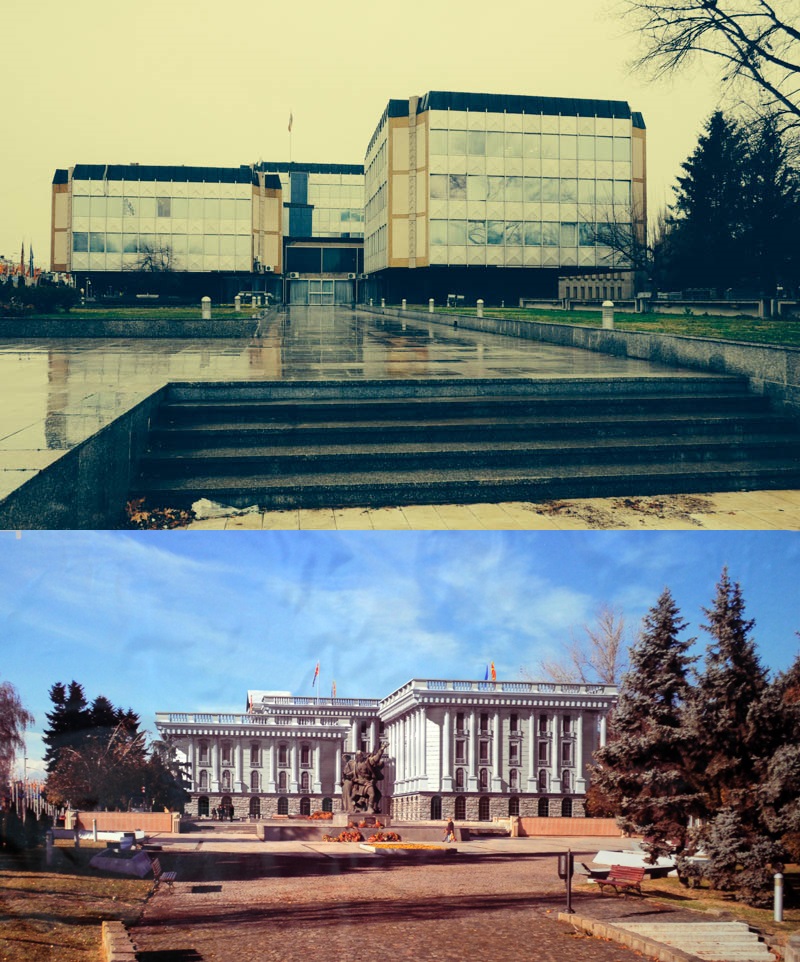
UPDATE 30th December 2014. A reader has advised of a public protest against the “Antiquization” of architecture in Skopje. There is a youtube of the demonstration, held in snowy wintery conditions underneath the Alexander the Great statue in the center of Skopje. The protest concerns the GTC shopping mall – the “Gradski Trgovski Centar”, but more generally the people are calling for an end to the fake Baroque facadism that is consuming the best of Skopje’s architecture. It makes me incredibly happy to know so many people are against the destruction of one of the finest collections of mid-century architecture anywhere on the planet.
UPDATE February 2018. On a personal note, I have returned to Skopje many times since this article was first written – almost every year, often more than once a year. In May/June of 2017 I spent more than a month in Skopje, staying (of course) in one of the Socialist-era apartment blocks in the center of the city. I’ve grown increasingly attached to both the city, and it’s citizens.
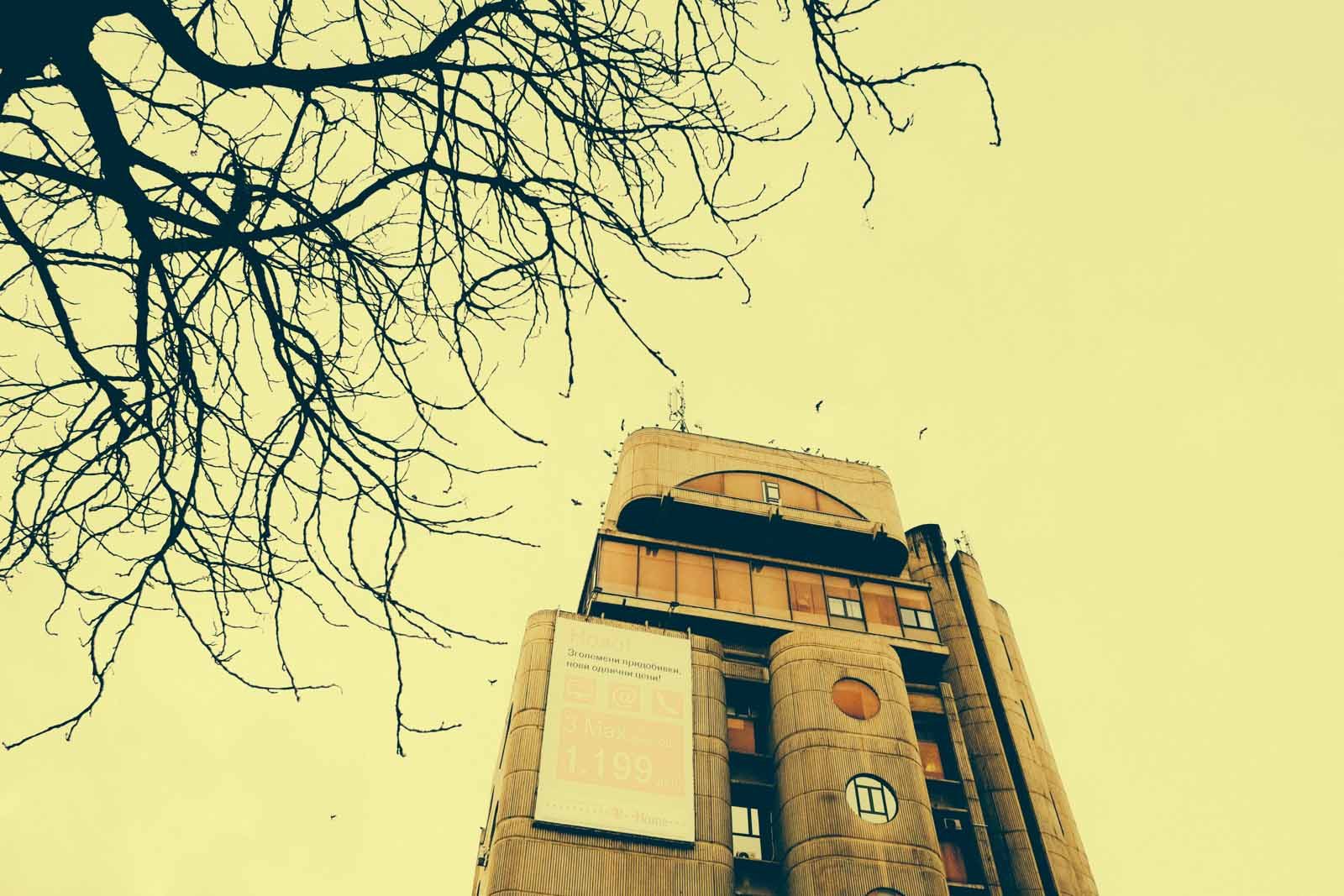
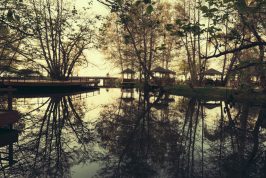
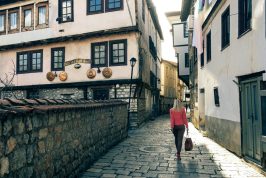

I’ve always been fascinated with this style of architecture. The lines, the rot of the concrete… on this alone I could see why you hung out here for so long.
Must make it there soon…
Me too Dustin. There’s a few nice examples in Germany as well, but I dare say they are much better maintained.
Great post. I couldn’t even being to pick a favourite of the bunch, although the News Publishing Agency and Post Office would have to be up there. It’s a real shame that a lot of this could be lost over the coming years – some things never change.
Yep. It would be a real shame. Hopefully there will be a change of priorities at some point.
Unfortunately what you see is allready past, The current government has changed the facades of the buildings into “baroque a la Skopje”. Many statues all around with no Connection to each other, and new heavy make ups of the buildings. Just google Skopje 2014 Project and you will see the kitsch and disney-like makeover of the city core.
That’s very sad, Jovan. I hope to get back to Skopje this year, and see exactly how far “Skopje 2014” has come…
I live in Skopje, and I must say with a great sadness in my heart,all that you saw is being brutally changed, and the face of the buildings is covered with some really bad “BAROQUE” style by the government. Skopje was never baroque! We were deep under the Ottoman influence. There were maybe 3,4, maybe 5 buildings in “baroque”, but those were the houses, or residential apartments for the European ambassadors. This is way so wrong what they are doing to this city. But the people that live in Skopje, can’t do anything!!!
It’s beautifull., and now I like it so much. I’ ve studied in Skopje and once it was a cold socilist style city. Now with this new beautifull buildings the city has gained a good spirit and it’s full with visitors and tourists. I take every chanse to stay in Skopje and I feel greate. It’s classic architecture. Romanic and Greek and this style can be seen all over the world. White House has been built in the same style. Why not Skopje?
This is now beyond a joke…
Only a new earthquake can help this joke of a city now. Ugly beyond any recognition and help. I’m sorry to say it, but you have awful taste.
When we were in Belgrade last year I couldn’t help but love the brutalist architecture, but then I can be odd like that from time-to-time.
Maybe we’ll give Skopje a visit in 2013.
I know what you mean about Belgrade (will be back there tomorrow!). Skopje is well worth a visit.
Please check name of river in Skopje
Thanks K, small typo, fixed.
VARDAR is the name of the river
Αmɑzing site web Natalie
Dear Nate, here is some missing info I managed to find:
Macedonian National Radio and Television building. Architect – Kiril Acevski, 1971-83
GTC shopping mall. Architect – Živko Popovski, 1973
Saint Cyril and Methodius University of Skopje. Architect – Marko Mušić, 1974
National Bank of Macedonia. Architect – Radomir Lalović, Olga Papeš, 1975
Macedonian Academy of Sciences and Arts. Architect – Boris Čipan, 1976
News Publishing Agency “Nova Makedonija” building. Architect – Blagoja Kolev, 1981
Keep up the excellent work and best regards from Zagreb!
Thanks so much Daniel! I will update the last few changes… the only one I’m missing now is the Student Dorm project…
Hope life is good for you in Novi Zagreb!
Wow, another cool set of pictures. I’m intrigued by the more cosmic/spacey look of these buildings, compared to the other cities you’ve photographed brutalist buildings. I don’t know, I think you may be converting me to a fan of this style of architecture. It’s such a shame about the government trying to “re-write” the history. All of it, good and bad, has brought Macedonia to where it is today. All of it is part of their identity, the government needs to learn how to embrace it all and the lessons to be learned from it. Not that my country has been perfect in this department, but it’s always better to be real than to, pick and choose what you present to the world.
Hey Noelle, yes, there’s definitely a little more “style” to many of the buildings in Skopje from this era, as opposed to some of the harsher examples I’ve photographed in other cities throughout the Balkans. And I agree, the government should preserve, and capitalise, on what they have – and be proud of it.
I personally don’t like brutalist architecture, but your photos are stunning :)
Loved to all the history behind them, BTW
-Maria Alexandra
Thanks Maria nice to hear from you again – yes, the history is really fascinating, and completely explains why there are so many of this style of building. The Brutalist style generally attarcts either a love, or hate, emotion – I totally understand it’s not to everyone’s taste.
I love big and ugly communist architecture, what can I say!
That makes two of us!
This was a very interesting view of the architecture in my home city, but I would hardly say it’s brutal. Even tho your photos are extraordinary, one has to come and experience the life of the city for themselves in order to truly appreciate the architecture.
The Universal Hall was a donation from the Bulgarian Government after the quake, architect is unknown.
Hi Marina – the term “Brutalist” refers to a style of architecture – there is a link within the article to an explanation on Wikipedia. Believe me, most of these buildings are very Brutalist! But no, not “brutal”, in the way you may be thinking. I spoke to the manager of Universal Hall, and he told me about the history of the building – I know it was from the 1960’s, and that it was indeed a donation (he said from the “international community”), but I forgot to record the exact year. It would be good if we found out who the architect was – the interior in particular is stunning.
There is only one missing, a masterpiece from Slovenian architects http://photos.wikimapia.org/p/00/02/09/19/27_big.jpg Macedonian Opera and Ballet / Architectural studio: BIRO71
Hi Rale – yes, I love that building as well. There is more than that missing from my article – I actually had over sixty photos I considered using. Maybe I can do a part two? The National Archives building is another one, for example, and I have plenty of apartment buildings, and office buildings that didn’t make this cut. So many great examples in Skopje!
Nate,
I really enjoyed all your articles about Macedonia. If you ask me, they can be combined as a tourist guide. :)
Thank you for them and for the promotion of our small country!
I totally agree with you on everything that you stated in this article.
However, there is another sad moment in the whole story.
Maybe it’s even better that the current government doesn’t maintain the buildings, because when they maintain, if you ask me, they destroy. Тhe plans for some of them are horrifying. As an example I would give the following two:
– the government building: http://www.build.mk/?p=24670 (which actually represents the architecture of a traditional house from Ohrid – http://twitpic.com/86d1jj)
– the MEPSO building – http://www.build.mk/?p=22449, http://www.plusinfo.mk/vest/50825/FOTO-Lavovi-kje-ja-chuvaat-novata-fasada-na-MEPSO
I guess this government is somehow feeling threatened from the things build during the communism. For example, I will never forgive them for erasing this message written on the Old Railway Station after the 1963 earthquake (I guess, for them, it was said by a wrong person)
http://livingndreaming.files.wordpress.com/2011/09/dsc03416.jpg
“Skopje has endured a terrible catastrophe, but Skopje will be rebuilt with the help of the whole society, it will become a symbol of brotherhood and unity, of Yugoslav and world-wide solidarity”
27 july 1963, Tito
He had a really nice vision about Skopje. I sincerely hope that some of the new plans will fail, and that it will be possible to fall for Macedonia, as you did, even after 10 years.
Best,
Ana
Hi Ana,
You are most welcome, I should thank Macedonia for having me.
Now, I looked at all of your links, and I am horrified. The MEPSO building, I took photos of. But, from your examples – the old government building, I visited, and took photos, and nearly included the photo in this article. In fact, now I will add the photo. Because, if it does change to what is proposed – it would be a tragedy. Your government needs to embrace this architecture – it is unique, and it has a lot of fans around the world. Sure, if they want to build new Baroque style architecture, go for it. But it’s madness to destroy the existing communist-era buildings. Pure madness, and they will regret it. But, I know you understand this.
The Tito plaque on the side of the Old Railway Station, that’s a tragedy as well. It is all of these small, but significant, features of Skopje that need to be retained. Whoever it is in the government that feels threatened by these reminders, needs to understand that not only is it not a threat – it’s actually the sort of thing that tourists like to see, and locals like to see as well.
Destroying heritage, especially when it is a positive message like that, is just absurd.
Thanks so much for bringing this information here.
Nate
Bravo Ana. Well said.
Hi Nate,
Thank you for capturing some of the beauty of Skopje. We tend to overlook it during our everyday lives.
I wanted to add that I think the building I live in is also fits in quite well in the brutalist tradition (I think, as I am no connoisseur of architecture) :) here’s a random google photo of them, they used to be the tallest towers in the past, also built by japanese I believe.
http://upload.wikimedia.org/wikipedia/commons/4/42/Tower_in_Skopje.jpg
All best,
Hey there… I’m pretty sure I saw that apartment building. Very cool. As you know, there are so many examples of apartment buildings from that era, I took quite a few photos, and even managed to stay in two different apartments similar to the one in your link. Sooo cool.
Finally someone else that likes it.
This concrete architecture is the thing i love the most in Skopje, and to be honest, it could have been an amazing city if the “Skopje 2014” project continued in that direction.
Hi Stefan – nice to meet another fan of this style of architecture. You make a good point – can you imagine if, as a part of “Skopje 2014”, the government was smart enough to restore and preserve all of these amazing buildings? It would just make Skopje an incredible city. I firmly believe they will regret it, should these buildings be allowed to decay. Thanks for your comment, enjoy Skopje.
Skopje now is much more beautiful :)
It is indeed beautiful.
Well, the current government hates the communist era buildings, and it will aim to demolish them in the nearest possible future. To them, those were bad times. Now, they like to build insanely disgusting BAROQUE!!! style buildings, since you know, BAROQUE!!! was always present on the balkan. And i can also add that, the people are not divided, 90% of them hate the new architecture, but this is a crappy police state, so nobody dares to comment anything, because they will most likely end up in jail for speaking against our AWESOME government. That is all i will say for now. (:
The new Baroque buildings are a bit wild for my tastes…and perhaps a bit tacky as well. It’s a shame people don’t speak up more, but I understand why.
Nate, people speak up, but they are not allowed to say much before they are silenced.
That’s a terrible situation to be in, really, my heart goes out to anyone who is “silenced” in any way.
Thanks for your article and pics, it’s always interesting to get to know what other people think about you (in a stereotypical manner, of course…)
Back in the days when I lived in Skopje and studied at “St. Cyril & Methodius” we used to joke that all those concrete, sharp-edged, grotesque, space-raping buildings are built in “Stalinistic Gothic”, a post-modern architectural style striving to suffocate man’s natural love for natural building materials, efficiency, simplicity and modesty.
I think communists have accomplished their mission – just take a good look at the world today…
Your title is “Communist Architecture of Skopje”, and you put a picture from Saint Kliment Cathedral. It doesn’t make sense.
Hi Bane – as I said in the article, I used the term to denote a period in time – which is why the title includes the word “Era”. And the Cathedral was most definitely constructed during this era. Hope you understand! Nate.
Great pics. Can’t wait to see some of these fading brutalist behemoths before they’re gone. Hope some are still standing this weekend.
Cheers Ian… I’m sure they’ll still be there… have fun!
I live in a town 50 km from Skopje. I think its ugly. Too much washed money for nothing.
I hear ya, Irena.
Great “original” Research, it needs a book, a few essays and a story to tie it all together , well done….
Im so happy to learn about this stuff almost first hand , the next best thing to being there
Thanks mate. Totally agree.
I find the title to be quite brutal and misleading. The architecture is quite modern and Skope should be proud to have it. Refreshing, new and stable to sustain the seismic disasters. Kenzo Tange, the architect of the Central train station platform in Skopje, is a world most renowned Japanese architects of the second half of the twentieth century managed to fuse the architectural traditions of his native Japan with the contemporary philosophy and traditions of the western world.
Unfinished exteriors and interiors for whatever reasons, and the building upkeep have nothing to do with the architecture.
Hi Kiril – the title refers to the accepted architectural term “Brutalist” which describes the style of the buildings featured. I think we actually agree with each other – if you read the article, you may think so too.
Hi Nate
I loved your article…finally someone who apreciate the REAL architectural heritage in Skopje..
here are few more buildings that you may find interesting, from that period
–https://fbcdn-sphotos-a-a.akamaihd.net/hphotos-ak-snc7/417322_2552350939170_609746359_n.jpg
(It’s the primary school “Johan Heinrich Pestalozzi”, build in 1967, by arch.Alfred Rot, donation by Swiss government after the earthqauke, first building with ruber anti-earthquake parts in the fondations)
— https://fbcdn-sphotos-b-a.akamaihd.net/hphotos-ak-prn1/400310_2552358299354_166645333_n.jpg
(the Catholic church, build 1973-77, by arch.Blagoja Micevski and Slavko Gjurik
— https://fbcdn-sphotos-b-a.akamaihd.net/hphotos-ak-ash4/427419_2552348699114_436505514_n.jpg
( “Josip Broz Tito” high school, build 1966, by arch.Vasilka Ladinska, Zivko Gelevski and Slavko Gjurik)
Thanks Dra – wow, three more great examples. I don’t think many foreigners realise just how many amazing buildings exist in Skopje!
they don’t beacause the building are not presented in the right way…..however here’s one more pic of
Glavna Posta (The Main Post Office) from the inside….example how elegant can be brutalism
best regards
https://fbcdn-sphotos-f-a.akamaihd.net/hphotos-ak-ash4/398014_4122657915863_354847432_n.jpg
in background you can see the “cubist” mural of Borko Lazeski (1917-1993)
Amazing. I have a lot of interior shots of many of these buildings…
I was teaching at the university and I lived in one of those buildings for 2+ years (SD Goce Delchev) . And, I had a chance to observe better. Partially deployed architecture is what I saw. Same with many buildings in Skopje, the buildings, their walls and windows never saw water or paint. In fact, I do not think I ever saw window washing crew anywhere. Beautiful architecture and filthy exteriors looks ugly. Detracts from its beauty. Perhaps many people started mixing architecture and filth and started hating the architecture for whatever reason. Who knows.
Very interesting article , it drowse attention to my city Skopje on Vardar river , capitol of Macedonia … The point of article was ( as I understood ) is architecture of one time that , as the time passes by , may become interesting for tourists, or even for architecture students . I feel that have I to say something about it since I live here … Since now no building that was pictured here was not changed or covered in any way . However there are plans of changing the government and GTC shopping center . But there are a huge changes in center area that are currently in progress , and hopefully will be over for a year and half . Although I don`t agree with a number and placement of monuments I can understand the effort of government to oppose attempt of Greece to change our name , identity and language . ( when you are grabbed on on your throat you just find something on your reach and fight back…) What I was trying to say that this central area ( where the most of activities are going on …) was with no idea , identity or form , so I hope in the following year or two we will see how it will look like . I`m inviting all of you to “check it out” .Hope we all will see something to enjoy in.
Thanks Strkov…the whole naming issue is quite bizarre to me. The rest of the world knows this country as “Macedonia”. It’s just a name, I think there are more important issues to worry about. My own city “Perth” has the same name as a city in Scotland, Canada, America, and even another one in Australia. I know it’s not exactly the same thing – but nobody is complaining that one Perth stole the name or identity from another….
Wow! I must confess Nate, I’m from Skopje, and I always hated most of these buildings, with some exceptions (the post office always seemed so futuristic and cool to me). When I went to university, I hated hanging around and spending time there, and I thought it was mostly because of the dark, cold and grey interior….
Now, after many years, I realize that the new statues and kitschy baroque structures are uglier than most of the things that were built before, and the reasons I hated going to lectures at university have more to do with the “substance” (low quality of studies and student services, and bad treatment ot students), rather than the “form”, the building itself :)
And with this article you make me see these big, concrete buildings differently, and you definitely make me appreciate them! When I see from the comments how many foreigners admire what we have here, I realize that we must not take it for granted or, even worse, try to destroy what we have as a legacy – from any period that is, not only from the communist era.
Excellent, objective, informative post and great photos!
Thanks for the kind words Marija. Yes, I guess one of the points is that personal tastes do change – but once you destroy your heritage it’s gone forever. Not everyone likes this style of architecture, but not everyone likes the new Baroque structures either. I think Skopje should be able to have both!
I am born in Skopje in 1969. Because of its -brutal- architecture your never had a feeling that you live in a small city. as kids we would walk from the suburbs to the center to -exist- among this unique structures. Just to be there was enough, we imagined that we where on the set of -Blade Runner- or any SF story. Especially the city shopping center and Art’s and ballet house which you haven’t photographed on this page. The madness of the ego and obsession with ancient history, simply -money laundering- as most of the people think and revenge politics have brought the distraction in to this great city and may i suggest erasing of most intimate memory’s of its true citizens. There seems to be no end to this madness since more building from 60’s and 70’s are getting ready to be facelifted beck in baroque. Any local criticism is being named as treason and the person labeled as -komunist- and since the only way to get an employment is trough the government, there is not much we can do. Europe is ignoring and happy to give loans(for now).Thank you for the beautifull photos and text, the recognition of tragedy sometimes is the only consolation but
the politics in Macedonia are more brutal then its architecture.
You are most welcome Vladimir, and thanks for the story about your childhood – I love reading that sort of story!
Dear Nate,
Thank you for this beautifully written article and amazing photos. As a native Skopje citizen (who currently dwells in more western parts of the world), I was moved to see how the raw beauty and the essence of my city have been captured through the eyes of a visitor. All these buildings define what Skopje means to me. And even more, they are part of my personal history, heritage and identity, something that the new kitschy-disco-grotesque constructions can never become.
Also, thank you for bypassing the complex political issues and just focusing on the city. In these years of intense debates about constructions and national identity, your post feels like a breath of fresh air.
Best regards,
Jana
Thanks Jana,
You’re most welcome. As you can tell, I enjoyed seeing all of these amazing buildings in Skopje as much as you enjoy remembering them through these photos. As for the political issues – yes – they are far too complex for me, so there isn’t much point in me offering yet another opinion. I would only hope that among all thew new kitschy constructions, these old brutalist concrete beauties are not forgotten about for any longer.
To be honest Nate, you haven’t yet lived under a communist regime to be able to discuss about what our current government does. By living all those years under one name, we (strangely, out of all 6 Yugoslav countries) lost our sense of Macedonism somewhere. I really hate mixing politics and architecture/art, but most of our population supports what is created nowadays, because after all – all those sculptures, bridges and fountains represent our history, so I guess like every other country we have the right to show the world who were the creators of our history. Except of course, the greeks who seem to have problem with us even after the Bucharest Agreement of 1913 was finalized (look it up somewhere, I’m sure it will interest you). I also agree with you that these communist architecture buildings should be renovated since they are too, part of our history. Plus, they make our town look more cool, kinda like Gotham City, only a lot smaller and shorter :) Anyhow, I like your pictures and kindly ask you to form your own opinion (don’t listen to any of us, Macedonians) about what is done in our city today, because I think we deserve a normal, centered city with many amusing sculptures like any other city, not a bunch of grassy areas with grey buildings that only make us more depressed.
Thanks Toni, I really respect your opinion. In my experience, most of the people I have spoken to do not support the newly created sculptures and architecture. Personally, I agree with them.
In any case – that’s what makes this world a better place – people having differing opinions, and being able to discuss those opinions freely and openly – and still remaining friends.
All the best, Nate.
Let me be clear , I do not support any party , and I do not agree with every move my government makes . But It`s not true that our mouths are shot here , it is even indecent to claim that . Regard to Skopje 2014 there was lack of mass discussion and testing citizens opinion. The project was presented as finished and done and that was a biggest mistake that was made . There is not any picture of center of my city that you have made before this … Let me tell you : there was no real identity in it , it was empty with no “physiognomy” at all. Now I can say there are too many elements … And that is the second mistake …
But I think that we should leave them to finish what they are trying to do and than debate …Regard to claims that majority of citizens do not support project I `ll send you today’s link of a poll in media : http://www.skopjeinfo.mk/gradot/1883746610/gragjanite-so-poddrska-za-proektot-skopje-2014 …
You can try Google translator …
Thank you Kiril. It seems like public opinion is divided, at the very least. And that’s fine – it’s not really the issue. To me, the issue is the neglect of the buildings featured in my article, and the obscene expense of these new buildings. That the old facades and buildings are being destroyed is a tragic mistake. And, if you want to read about freedom of speech/press in Macedonia, I suggest you read this: http://novatv.mk/index.php?navig=8&cat=6&vest=3966
Nate, huuuuge thanks for this great article on our true building heritage. It’s real shame these buildings are left to decompose over time with no care for them, but this kind of behavior is perhaps a trademark for us here. :( Numerous Byzantine churches and monasteries are also neglected, and old-town architecture is on the list, but near the bottom with only a few renovated houses.
It’s ironic but in the past I didn’t care much for them Brut buildings either. It was only after SK2014 project started with its false neoclassicism and baroque that it opened my eyes towards the real and present beauties in my home city.
Unfortunately, they don’t seem to have a stopping point for the “project”. It continues to devour the city core with new “ideas” almost daily.
Just a few days ago there was a presentation in the medias for building “Spanish steps” (highly resembling the ones in Rome) and 2 days later the “baroque solution” for GTC (City shopping center) also appeared.
BR and safe travels.
You’re welcome Filip – and now I feel a little ill just thinking about what is going to happen to GTC ;)
Thanks to you Nate , I read the article and it is a common and daily quarrel between two different opinions… I agree that first one is trying to use your article and convert what are you trying to say .
The main problem at mine opinion with those buildings is that they don`t have a real owner … The problem that we suffer in this transition is that a lot of property ( which ” belongs” to all of us ) suddenly become every bodies and nobodies …The other problem is that when they are build we didn`t have concept of self maintaining , or regular input of money that will give those buildings chance to keep in good condition … But any way , as I said before , non of this buildings are planed to bi destroyed or covered , except the Government building and GTC shopping center … I think that we should wait and see what it will become like … Regards .
Nate, you are talking about “communist” Yugoslavia, but although it was a Marxist–Leninist single-party federal republic, it was actually “socialist” Yugoslavia, hence the name “Socialist Federal Republic of Yugoslavia”.
Thanks Tim, I seem to have been having a lot of discussions on this issue lately, and am glad for the education. Although I appreciate there are some naming issues here, there is a lot of respected literature that refers to Yugoslavia being “socialist” and “communist”. There clearly were elements of both. Either way, no disrespect or re-writing of history intended from me.
Hi Nate,
Thanks for summarize this period in the architecture! A great book can be made for sole purpose of documenting that period and for future references for architects…
I never knew that the actual name of this direction was called “Brutal”. Although I see you were explaining above about the name “Brutal”, how it’s actually a positive description, but let me tell you it tells itself “IT IS BRUTAL”! :) Skopje’s buildings build after 1963 always seem brutal to me, ugly and uninviting.
I grew up in the Kenzo Tange building (Gradski Zid) overlooking the Main Post Office. I literally (for 20 years) woke up every morning with that view. So out of sentimental reason I like that building, but in general I absolutely DO NOT like any other one of that period.
All this buildings have NO soul, are a mass of concrete in massive geometrical shapes. They are stripped of positive emotions and you can look at them and they just leave you motionless and empty. They seem very austere, industrial. Almost like they have no life in them. That kind of architecture can be perfect for a well industrialized country as will reflect the spirit of the people (disciplined, punctual, hold (control) their emotions, very formal, very professional, etc…). And that is not a bad thing at all! I can see them build in Germany, or Europe (North), or Japan, but really Not in Macedonia.
They simply DO NOT go with the spirit of the people, our culture nor with our values!
Even if some people are criticizing “Skopje 2014”, believe me it’s safe to say NO ONE longs for the “Brutal” architecture. It just never got “under our skin”. It was something that was forced on us. I would take Skopje 2014 any time over the brutal architecture…
You traveled through Macedonia and you see the character and mentality of the people. We are emotional, we like everything to have emotions, soul, ethnic feel, we tend to wear our heart on our sleeve, we are touchy-feely, tight-knit families, friends, we like it everything made by hand: from our ajvar, burek, pita, crotchet table tops, filigree, hand carving wood to custom-made dresses and jackets. Even the agriculture is not highly mechanized.
So even if we have a great “collection” of “brutal, communist” building, they are just out of space in Skopje and in Macedonia.
p.s. 1. But since they were already build and we have them, I think they should be cleaned (their facade), maintained better and tons of trees and grass (to be planted around) to balance that austerity. Even if they are ugly, I assume they were seismically well build, so out of that “practicality” they should be preserved.
* And maybe a good reference book should be made for Art and Architecture Schools…
p.s. 2. I have the utmost respect for Germany, Japan, Northern Europe. I studied in Paris, and my roommate was German, from Dusseldorf. I was absolutely stunned about her discipline, she was literally like a machine day in and day out, and all that was really good – that is why Germany is one of the most industrialized and wealthy country. And no matter how much she tried to “convert” me to be “German” she couldn’t. :) I am Macedonian through and through.
Hi Eliza – I actually stayed in your building whilst I was in Skopje – the photo of the Post Office should be a familiar view to you.
I thank you for your comment, and adding to the discussion.
Thank you for the reply!
I am very familiar with all the buildings, and yes especially with the Post Office. Not only you stayed in the same building, it is possible you stayed in our apartment (as my dad has been renting it for a while) and the photo that you have is the exact view that we have from our living room, bedrooms…
But I just wanted to add one more comment:
Regarding the comments above that “the government is silencing people”?! that is really not true. I would say more that the government is just not listening what every single person has to say. But can you blame them?
I have few architects friends and although they criticize “Skopje 2014” none of them is in agreement how the renewal of the city should look like! Each of them has a different opinion. And imagine listening to 2 million people, you will get 2 million different opinions and directions!? so no matter which direction you take, the rest will not be happy…
The architecture department of the university staged an open peaceful protest against the proposal. They were later assaulted by police and pro-demolition supporters. Silencing protest is the exact example of “the government silencing people”.
The current government and the previous do not have a great record for listening to opposition groups on most topics. The partitioning of newspapers by party lines contributes to this. This can be confirmed by Macedonia’s low standing on the press freedom index. But this is a discussion which has no place here.
The architect lobby against Skopje 2014 does not oppose the new buildings, merely enforces protection of existing buildings and the rights of the authors. This includes older buildings build during the Ottoman Period and the protection of classical Modernist structures built before the earthquake.
Excellent article. Loved the pictures.
Having seen the before and after of Skopje, it brings tears to my eyes. I really think you got a feeling for the city as it developed after the earthquake.
The 2014 change is inevitable, a second earthquake really, since this is a region which wipes out its own history with every decade.
Also an excellent article to add to the neo-classical kitsch devouring Skopje:
http://www.phaidon.com/agenda/architecture/articles/2013/march/04/skopje-chops-soviet-gems-in-favour-of-new-builds/
The article is good, but the title (some of it) couldn’t be more wrong. Sensationalism through the roof.
As a style that originated in the western world, there’s as much Soviet in the mentioned buildings as there is in Montreal’s Habitat or Boston’s City Hall (or countless other examples).
Thank you for sharing, great post!
Hey Nate ,just to let you know that the governmental building is being demolished (or maybe better said dissolved) in the last few weeks , so the project of reconstruction of the building in “neoclassical” style began , another thing is that the city center (the shopping mall next to the main square) has got new solution for reconstruction and guess what , it is in neoclassical and baroque style … but nothing is sure as there is big support by the people for the architectural bureau (or association i have no idea) protest against ruining that building.
BTW there has been news that probably in the next few weeks the fortress in Skopje will be open for visitors (but probably they will have some entrance fee).
Greetings from Skopje, Macedonia.
PS: Hope that you will come back to Macedonia and maybe we can meet.
I was in skopje in 2011 and your description is exactly how I felt about the situation!! Of course the plaza where the “horse statue” is located IS very pleasant but there is a very different feeling than when I was first there in 2002. I really hate when a city does not feel authentic and I think Skopje is losing that a bit. However, I was pleasantly surprised by your photo of the national radio and television building… I’ve been there with my grandfather-in-law because of some passport issue. What is memorable to me was that the people there recognized him as the retired chief of police from a more rural area of the country. It’s amazing to me that the whole of Macedonia is like a small town where everyone seems to know everyone. Point being, I don’t think the people are inauthentic and I think they will save the city.
There is no heritage that can be left from the communist era. There is only a blocks of concrite, which was made in the period of 1965 – 1985 because the communist regime wanted to help the factories that was working with losses.
The style isn’t called communist architecture, it’s called brutal architecture or brutalism, witch is spawned from the modernist architectural movement.
Yes, that’s why in the very first sentence on the page says : “Skopje, capital city of Macedonia, is a dream world for lovers of cosmic concrete communist-era architecture. There is a reason that no other city on Earth has as many examples of brutalist architecture.”
And in the second paragraph, I wrote: “Back in Skopje, 1963, the architectural trend wasn’t art-deco, it was modernist, with a particular focus on concrete brutalism”
And I provided a link to http://en.wikipedia.org/wiki/Brutalist_architecture in the third paragraph.
I also added further in the article: “Of course, it isn’t “communist architecture””
There is much more in the article which also further explains exactly what your comment says.
But thanks for stopping by, Tamara.
If it was only the disneyesque pseudo-Baroque stuff…
On German media much is being said (e.g. here: http://www.ardmediathek.de/br-fernsehen/capriccio/skopje-wird-zum-geschichts-disneyland?documentId=19137130 ) about the epidemic of statues exalting the glorious past of the place.
Hundreds of tacky monuments are being erected all over the place, including a 23m high representation of Alexander in Skopje’s main square.
All that money would most probably be better on something else instead of trying to create a hybrid between Pyongyang and 1970’s Bucarest. The existence of 1960’s modern architecture shown in this post came to me as a surprise.
Hey there!!
I had the chance to visit Skopje two years ago and it was the most fascinating trip ever…. I loved MKD and everything about its short history, gastronomy and lovely people.
Thank you for making me feel like I was walking on those streets again !!
Good luck on future travels.
Hi,
I have been living in Skopje for few months in 2005 and I was there for a course of Aseismic design of buildings. I had to hear about those buildings for three months.
I admit they are not so pretty but they had a certain fashion and the space in the city especially along the Vardar river was giving the impression that you could breath. I returned there in 2011 and I sow a horrible city with all those fake ancient buildings.
I am a fan of archeology and I really prefer old buildings instead of these modern concrete structures but in Skopje that fake ancient center is worse than the Kenzo concrete.
Great that you’ve photographed all these fantastic buildings in skopje, not sure anyone else has recorded them – and I follow a lot of brutalist feeds, eg. on instagram, Russian fans call the soviet era version of brutalism ‘sovmod’, wonderfully decorative, sculptural pattered and space-age influenced things.
Hopefully those big ones will mostly escape the classicalisation of the main square, which is indeed particularly awful – classical revival can be done well, but these are all mis-proportioned and lacking sufficient detail. Except that last one which looked frighteningly like the Bucharest parliament style!!
“Sovmod” is a really useful term – I hadn’t heard that one before. Cheers Rohan!
Hey Nate,
I was actually just in Skopje a few months ago and I can answer exactly why there’s a big push for all of this construction, and it’s simple: government officials receive kickbacks from city-appointed contractors for every job. So, the more construction, the more money in their pockets.
Thanks for a wonderfully put together piece of writing. And lovely photos, as usual.
Jeremy
Hello!
We’re in Skopje since two days, so far the main post office is the most beautiful building in the entire town. We couldn’t stop making photos…
Unfortunately our hotel is in the middle of all these ‘Skopje 2014’ fake neoclassical style buildings. Believe me, it’s absolutely surreal. Like artificial buildings in a movie. Walking on the moon couldn’t make me feel less strange.
I just hope they won’t touch the main post office. But I have strong doubts. There was a big fire inside the public hall of the post office some years ago. So far no one started to repair this beautiful example of Brutalism.
Hello,
first of all, you’re blog is amazing and I am so glad that you wrote this excellent post about Skopje. But you should know that not only Kenzo Tange was responsible for rebuilding a Skopje after the earthquake – much more important were two Polish people, Adolf Ciborowski and Stanislaw Jankowski!
Secondly, I would like to ask you if I could use your great photos in my blog. I am currently in Skopje, writing my master degree thesis about Macedonia and also a blog and articles about this beautiful country. I will be glad if I could enrich my post with your photos.
Regards,
Hi Justyna, thanks for your lovely comment, and the extra info about the architects. Please, go ahead and use my photos, on the condition you place a link back to this page.
Cheers!
Nate
https://cdn.yomadic.com/wp-content/uploads/communist-archiftecture-era.jpg
the autor of the sculptura is a famous macedonian architect Aleksandar Nikoljski (you can add this information under the picture). Great artical
Hi Nate,
a few brutalist suggestions for next time:
1. Skopje City Archives (near Skopje City Mall and near the student domitory Goce Delcev)
2. Medical high school (located at the foot of the clinical centre in Skopje)
Btw i’m very glad that you keep coming back in Skopje, and like th city.
All the best!
Thanks Dean, much appreciated. I was in Skopje again during April this year!
What can I say? Since I discovered your blog I’m in love of what you write! Your feelings and thoughts about communist heritage makes me wish to be there or try to run to the next bus to the destination you have been in the Balcans. Thank you so much for that! It’s not easy to find this kind of article where you can learn much from places, imagine them, see great pictures and wish to go there.
Now, I will read you about Irán… I read about women travellers so your articles will push me a little harder! Mny thanks from an uruguayan in Bulgaria ;)
Hi Ana, thanks for such a nice comment. Come to Iran with me, I will show you the time of your life!
Cheers,
Nate
I spent the month of September 2019 in Skopje, taking photographs.
Wondering if you want to see any of them, as I visited many of the buildings you have here.
Thank you so much for such an amazing piece!